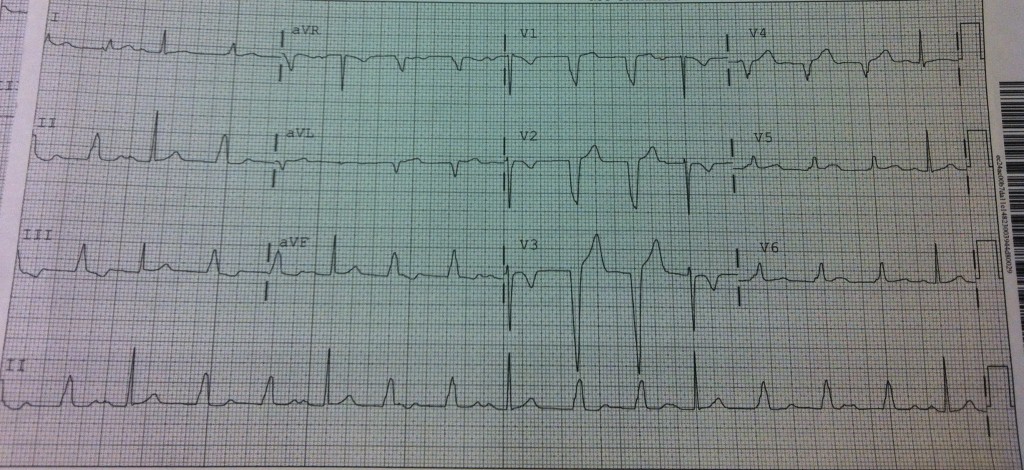This 18yo F presented with one episode of chest pain which lasted a 2-3 minutes, was left sided, sharp and 8/10. Vitals in the ED were BP 112/71 HR 106, RR 18, T98.9. The above EKG was obtained as part of the workup for ACS.
Post your questions/comments or an interpretation in the comments and the answer will be posted next week!
The views expressed on this blog are the author's own and do not reflect the views of their employer. Please read our full disclaimer here. Any references to clinical cases refer to patients treated at a virtual hospital, Janus General Hospital.
The following two tabs change content below.


nchristopher
Latest posts by nchristopher (see all)
- What’s wrong with this picture? – Answer - September 11, 2013
- What’s wrong with this picture? - August 21, 2013
- EKG Case 8 – Answer - July 16, 2013
- EKG Case 8 – All that wheezes - June 19, 2013
- EKG Case 7 Answer - June 19, 2013


Nice rhythm! More history please. ACS……?
Agreed like the ECG. Interesting that the wide complex is regular while the narrow complex is irregular. In real life I would want a previous ECG if that’s possible, previous hx.
I’m doing it for the giftcard.
rate: about 100
axis: nml
not sinus. Looks like occasional p waves converting to narrow complexes qrs with intervening wide complex without p wave preceedings.
Looks like most p waves present lead to narrow qrs’, but possibly two dropped beats here.
Possible delta wave seen best in V6 (but no p wave here).
Wide complex tachycardia, regular, without p waves.
Not Vtach as some p waves get through. Not afib as wide complexes regular.
Most likely diagnosis: aberrant alternative track leading to AV nodal based tachycardia (such as wpw). Occasionally, p waves make their way through to the AV node when the tracts are not in refractory period and gets through.
Grock going nuts! Nice. But you LOOK for p’s in VT as a sign of AV dissociation….
Well you know that there’s a regular ventricular rhythm but its faster than expected (idioventricular perhaps or “slow VT”) .
There is AV dissociation and no INTRINSIC aberrancy bc there are normal, intermittent, probably regular, slow p rate followed by narrow QRS.
Sinus bradycardia with accelerated idioventricular rhythm. Myopericarditis? Hypokalemia?
we have two distinct QRS morphologies. We have narrow QRS’s at a super slow rate and somewhat regular. Is this sinus brady? Sinus arrhythmia? Or is it something more pathologic.
The narrow complexes occur pretty regularly initially at a rate of ~30bpm. They are preceded by what appears to be p waves. With respect to these “sinus beats,” they have normal axis. he PR is long, >200ms at first, but much shorter preceding the last narrow QRS. The QT and QRS intervals are wnl. There appears to be some scant STE in 2,3, AVF ( may be reaching). Are there PR depression too? Tough to say as we’re given relatively few of these “sinus beats.” The T waves are flipped in V1-V3. They are asymmetric and shallow. And given the patient’s age and sex, are likely a persistent juvenile pattern and benign. However. Ischemia or RV strain pattern is possible. No Q waves are seen. No LV or RVH.
Of note to me, is the appearance of what looks like a nonconducted p wave after the 4th narrow QRS. There is also that pesky shorter PR in the last narrow QRS. The conjunction of a bradydysrhtymia with changing PR intervals and dropped beats suggest an AVB, possibly mobitz 1.
With regards to the wider morphology. They are wide, >120ms. They are regular. They occur at a rate of ~100bpm. They have a LBBB morphology. However, we see conducted “Sinus” beats with block or qide-QRS. . And its not as if it’s a sped up impulse or a rate-related BBE. We see AV dissociation so it’s of ventricular origin. As Dr Desouza said, the rate precludes Vtach or true “ventricular escape.” So this is likely an accelerated idioventricular rhythm (AIVR).
Putting it all together. We have a very slow sinus rate. I think ~30 bpm. With a dropped beat and inconsistent PR intervals….I think there is underlying underlying Type 2 aVB, possibly mobitz 1. We have AV dissociation with incomplete heart block and a sped up ventricular rhythm . I like myopericarditits with the rhythm disturbance and the AIVR, with the scant STE and pr depressions. I may be fabricating them. Other possibilities include dig toxicitiy? Ischemia. Drugs. ‘Lytes.
Nice, Freedman. But, I suspect that the p rate is actually around 60 and some of the atrial impulses are reaching the AV node while it is refractory from the idioventricular rhythm.